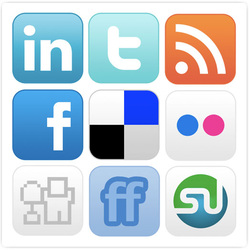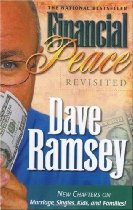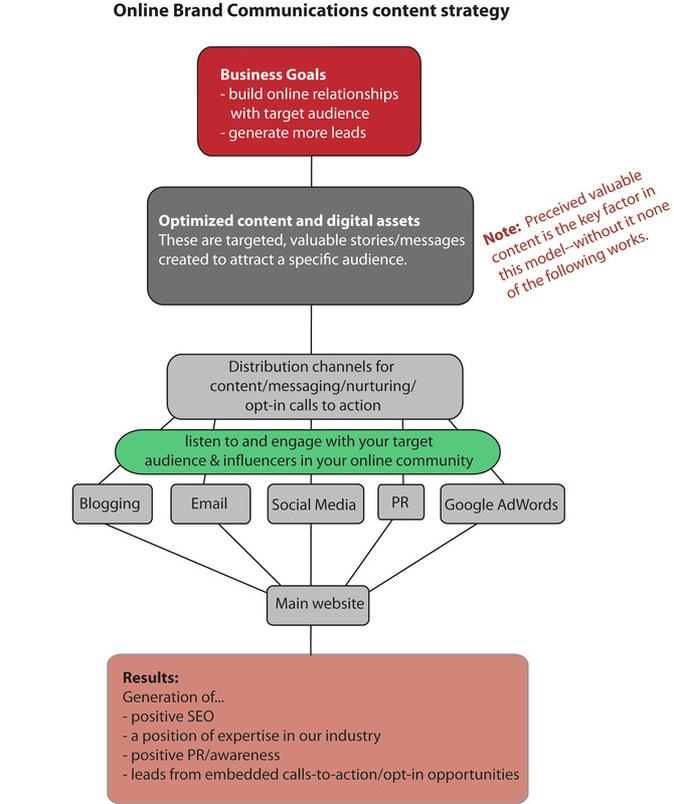|
The Internet is the new Yellow Pages in several respects, but a major difference is the Internet allows for better results quicker and with more accuracy related to what you’re seeking. This is key for folks trying to find the types of products and services your business offers. However, if they don’t know the name of your company how are they going to find you in their searches? --with keywords that describe what they’re seeking. So your company needs to figure out what keywords its ideal customers are using to search the Internet for the products and services they’re interested in, which may be the same kinds of products and services you offer. Search engines can help match a seeker with a seller of what is being sought. So how do you make it easier to be found online - start here (information directly from Google about search engine optimization). Also, I’m a big believer in blogging. It creates new, valuable and regular content for visitors - giving them a reason to come back often and each blog post essentially is another web page to be searched by Google and a way for you to be found. So by blogging, in terms of SEO benefit, (to use a baseball analogy) you’re going to bat more often so your batting average and on-base percentage (i.e. being found online) will be higher. This translates into more opportunities to engage with prospects, convert prospects to leads right from your website and close more business. This is often called inbuond marketing, which is part of what I call your online brand communications strategy. So if you’d like to ignore the Internet to help market your business you, I would not advise it. If you want to spend a lot of advertising dollars for traditional (outbound) marketing tactics that are no longer effective, you can, but you might want to consider Internet marketing, which could more easily and efficiently help your business grow in a cost-effective manner more quickly. Here are a couple of supportive stats from HubSpot, an Internet marketing software company: - Companies that blog get 55% more website visitors - Inbound marketing costs 62% less per lead than traditional, outbound marketing Posted by: Nick Venturella  Lately I’ve been reading The Referral Engine (Amazon Affiliate) by John Jantsch, the author of Duct Tape Marketing (Amazon Affiliate). The Referral Engine is essentially about how to make your business a highly referable business to more easily generate leads that are likely to close. I’m only part way through the book, but one of the lessons that stands out is the idea that most business operations fall into two general camps: wired businesses that utilize technology and social media, etc. and more traditional off-line businesses that are more person to person relationship-based. Here’s what I like about what Jantsch is getting across. Jantsch basically says that if you’re a wired business you need to find ways to develop more person to person interactions and relationships, and if you’re more traditional business you need to find more ways to utilize technology to help further connect. A referable business has a good balance of both. These days one can use technology to help conduct their online brand communications toward the goal of generating and furthering business relationships, but we can’t forget that technologies are tools. There are still people behind the technology, and vice versa, people need help connecting further, farther and faster in today’s economy simply to keep up, so those who typically don’t want to embrace technology will find themselves left behind if they don’t. However, the commonality here is that people run businesses. Technology can help you run your business and that’s a good thing, but it’s only a tool. Likewise, tools are good, but the real value in any business is the relationships created and maintained between people. Posted By: Nick Venturella  I read a good post today, Raidious' Three Pillars of Social Media. Raidious is a content marketing firm. In this post they break down some of the basics your company will want to be aware of with your online brand communications. Basically, they break it down into three sections (or pillars): content, monitoring and moderation. I really like what they had to say about content: "...content is king regardless of the platform. Content is anything you post on your pages in order to interact with your customers. This could be a Facebook post, a tweet, photo, video, link, etc." That's what I wanted to focus on for this post, content vs. platform. I adhere to Raidious’ philosophy that the engine behind successful inbound online brand communications is regular valuable content. The content (and backlinks) is what helps your SEO. It matters less which social media platforms you use to distribute your content as long as when you do you’re making valuable connections toward new and strengthened business relationships. This is also why it’s increasingly important for companies to have a blog as part of their website, so they can own their content. Think about it, what if Facebook ever crashed and your company lost everything that was on that platform...if you own your content you could rebuild a presence more easily on a new platform. Posted By: Nick Venturella  So why is social media important to your online brand communications, or internet marketing, or inbound marketing, or content marketing - whatever you want to call it? You get the idea - it goes by many names with many facets. For the purposes of this post I’ll refer to it mainly as online brand communications. When you really break it down into its simplest parts, what does it look like? What is at the heart of this kind of social marketing? The basics about the appeal of online brand communications for businesses begins here: Communication and Relationships It all revolves around communication and relationships. Communication is the vehicle driving connection with others to form relationships (both personal and business relationships). Friends, and friends of friends Users of social media do so to stay in touch with friends (maintaining relationships with digital communication through a social media platform that makes it easy to do so). Users also use social media to discover new information and people (often being introduced to friends of friends in their current network - sharing and communicating among them, which exponentially spreads communications and builds farther reaching relationships - this leads us into the next bullet point) Heard it from a friend, who heard it from a friend Discovery plays a significant role in social media and certainly in online brand communications for businesses. For each relationship maintained online, that person is a potential source of new information that can be shared with you easily because the two of you are connected online and the social media platform makes it convenient to review newly posted info from one another and others with whom you have relationships. So for example, if you and I are friends online, you likely have a whole bunch of other friends or connections online beyond me, most of whom I’m likely not directly connected to. I’m only peripherally connected by my association with you, and the same is true for you with many of my connections. Because of these varying degrees of separation and the ease of transferring communication among friends and friends of friends (due to exponential levels of direct and indirect connections) social media platforms make it easy to rapidly discover new info shared by you, your friends and your friends’ friends. Word of mouth on steroids Because information can be shared rapidly and exponentially across social media platforms, by way of these one to one online connections that often have vast additional indirect connections of friends by association, so many observers can see and spread the original one to one message quickly like word of mouth on steroids. That quick and rapid reach of messages delivered in a word of mouth fashion, and the cost-effective use of online social media platforms, makes this way of communicating and building business relationships attractive to companies. Recommended reading: Inbound Marketing: Get Found Using Google, Social Media, and Blogs (New Rules Social Media Series), By Brian Halligan, Dharmesh Shah posted by: Nick Venturella  So, I’ve recently enrolled in Dave Ramsey’s Financial Peace University (Amazon affiliate), which is a 91 day personal finance course. I do alright with my personal finance, but I’m always looking to improve. One thing that really resonated with me in the first session was Ramsey’s description of money as being amoral. Amoral, means something is neither good, nor bad, it simply is. Ramsey speaks of money being amoral, neither good, nor bad, but it’s what we as humans do with it that makes it seem good or bad. The choices we make with money to become greedy jerks, wealthy goodhearted folks, poor resentful people or working class good souls is up to us as humans - the money just is, it doesn’t care one way or another, it’s amoral. That got me thinking about social media, and many business’ fear of the chaos that realm may bring onto their brand. Social media is amoral, it’s neither good, nor bad, but what businesses do with their marketing and online brand communications in that arena could impact your company and it’s brand in a positive or negative way. Something to think about. Posted by: Nick Venturella The following is a visual representation of an Online Brand Communications content strategy. This is an attempt to help visualize and somewhat simplify the flow of info/content in such a strategy.
Let me know your thoughts by commenting.  This morning I simply wanted to make you aware of a new section on the Nick Venturella Media site. Introducing (Do It Yourself) DIY Education. This is an online book store (Amazon affiliate) with useful and empowering books that I’ve read and recommend for other business owners and creative entrepreneurs. You don’t always have to be in classroom or have formal education to gather the knowledge you need to run your business. I’ve learned plenty from the books in this section, in fact, the majority of my business education came from these books and my application of their ideas...and yes, failing, reflecting and improving as I keep moving forward. What I like about learning this way is that with each book I get to piece together my own self-paced curriculum tailored to me and my business. Within this section I plan to feature one book each month, which you’ll see right at the top of the page. This month it’s Richard Branson's book, Business Stripped Bare (Amazon affiliate), which I also reviewed in the nickvmedia brand communications blog. Happy reading. posted by Nick Venturella  Annie Cat, made in Brushes app on iPhone So here’s another iPhone Brushes painting I did (on New Year’s Eve, actually). This Brushes painting is of one of my cats. What do these little iPhone paintings teach us about being creative entrepreneurs? To me, it’s a larger sense of enthusiasm, creativity, innovation and connectedness made possible by people using various tools to create and distribute their messages to specific audiences at a regular clip with little barriers to production and distribution - all with the idea of communicating toward building relationships. My point is, if you’re a creative entrepreneur, or really are in any sort of business, I think it’s wise to take full advantage of the available tools to create and distribute your messages to groups and individuals with whom you wish to connect. Forget muddying it up by calling it social media or being intimidated by the technology of it all – these are simply tools to help communicate your messages to build (at least in this day and age) farther reaching relationships that you would not otherwise be able to engage in without such tools. What's your favorite tool to communicate toward building relationships? Posted by: Nick Venturella  If you’ve ever read the book Made to Stick (amazon affiliate) you know that one of the elements of “sticky messages”--that is messages that end up being memorable and easy to recall--is being concrete. What the authors of Made to Stick were talking about was using commonly recognized imagery and ideas in the language used to communicate your message. In the book they give the example of Aesop’s fable about The Fox and the Grapes, which is where the term, “sour grapes,” comes from. The fox story is concrete in that it talks about how the fox couldn’t eat the grapes hanging on the vine above him, just out of his reach. In the fox’s defeat the fox proclaims the grapes were likely sour anyway. The lesson learned was that it’s easy to despise that which we cannot obtain. My point (really the point of the authors of Made to Stick), is to the extent you’re able try to be concrete in the way you talk about your company’s brand, in the way you display imagery regarding your company’s brand (logo, identity design, etc), in every way you outline the benefits of your products/services, etc. Give folks clear imagery that is common enough for them to wrap their imagination around. This is extremely important in service companies that don’t necessarily have a tangible product to sell. This video from HubSpot is humorous, but useful in that it displays the difference between inbound and outbound (or pull vs. push) marketing efforts. By utilizing a company blog, social media, email marketing and other such efforts to distribute valuable content to a targeted audience (your ideal customers) you will be better positioned to be found online and create online conversions whereby you're capturing valuable prospect information in return for offering valuable content to that prospect. Thus, you're building a pipeline of prospects that you can continue to nurture with valuable content until they're ready to buy. For the purposes of our video, let me ask, when was the last time you looked something up in the phone book vs. Googling it? Essentially, that's how inbound marketing works--create content, boosting SEO, get found online, create conversions, nurture prospects until they buy, improve the process and start again. |
|


